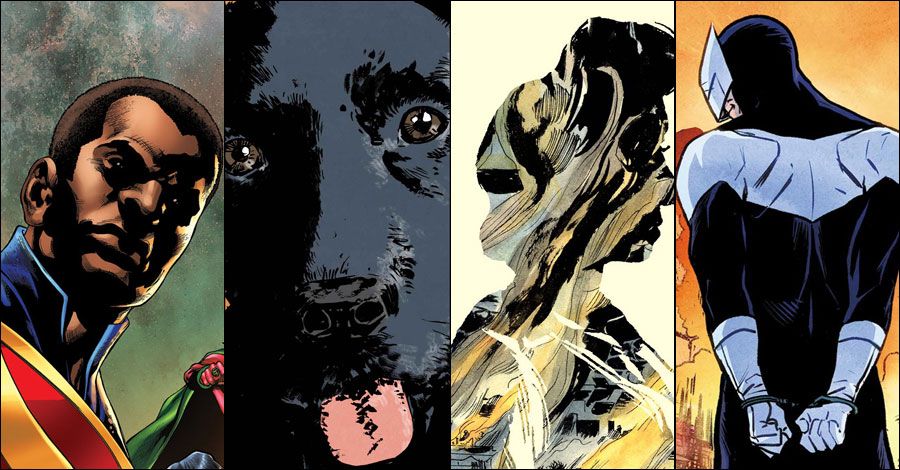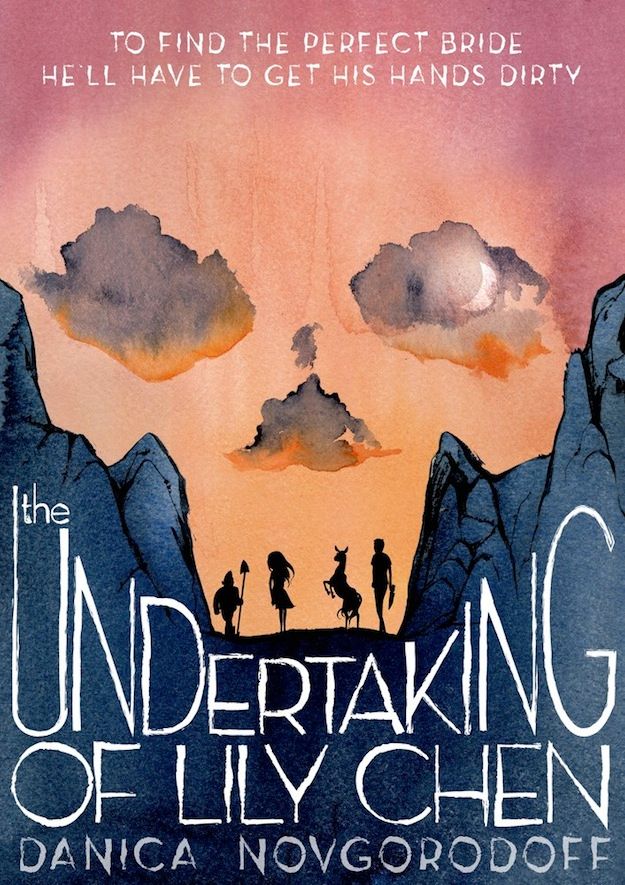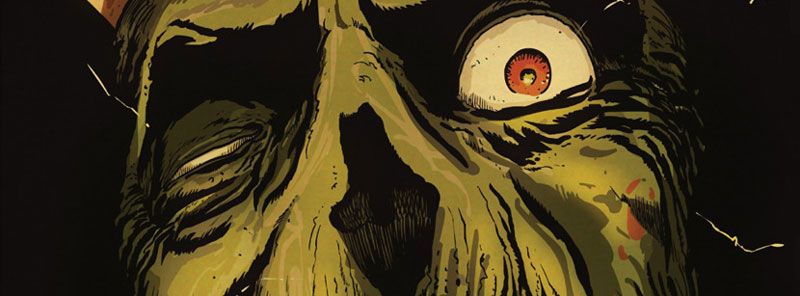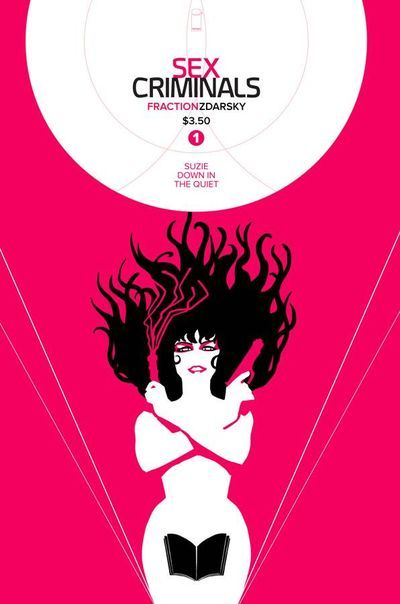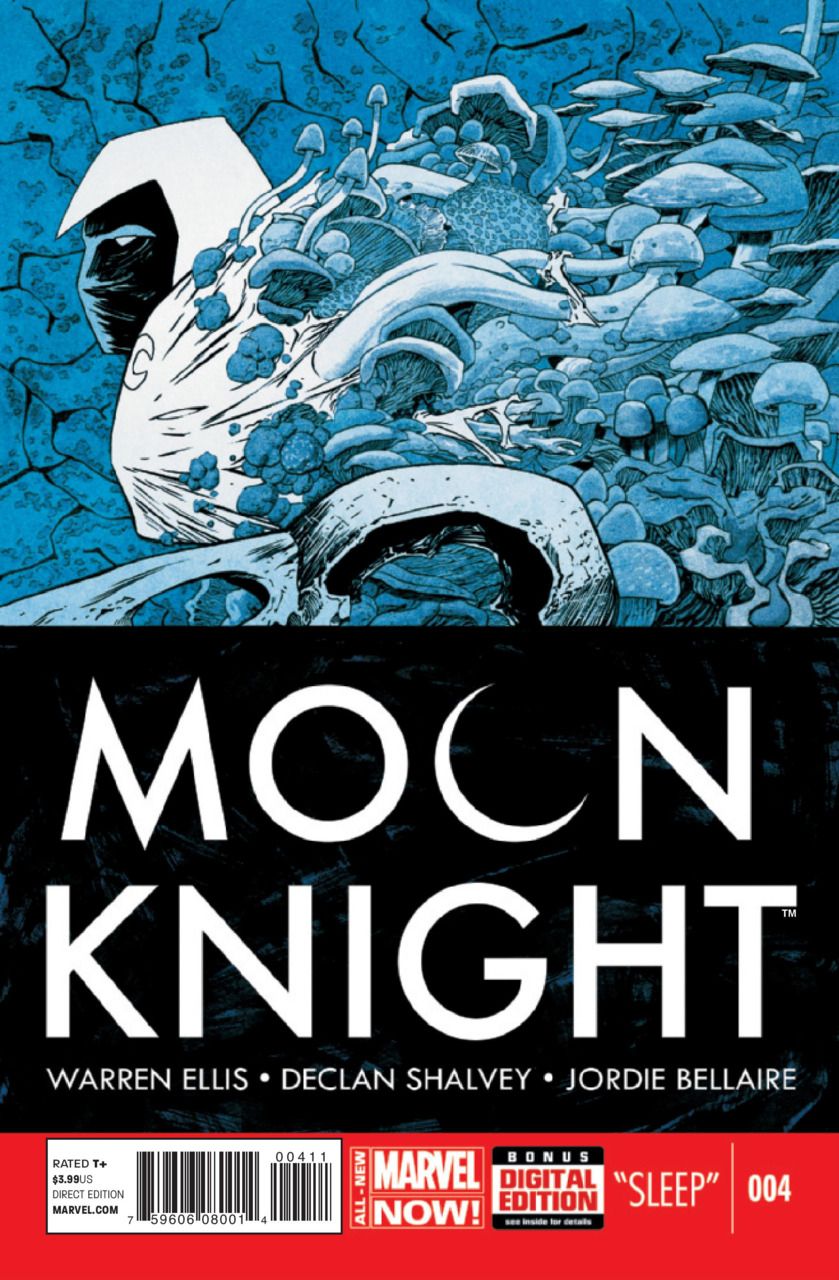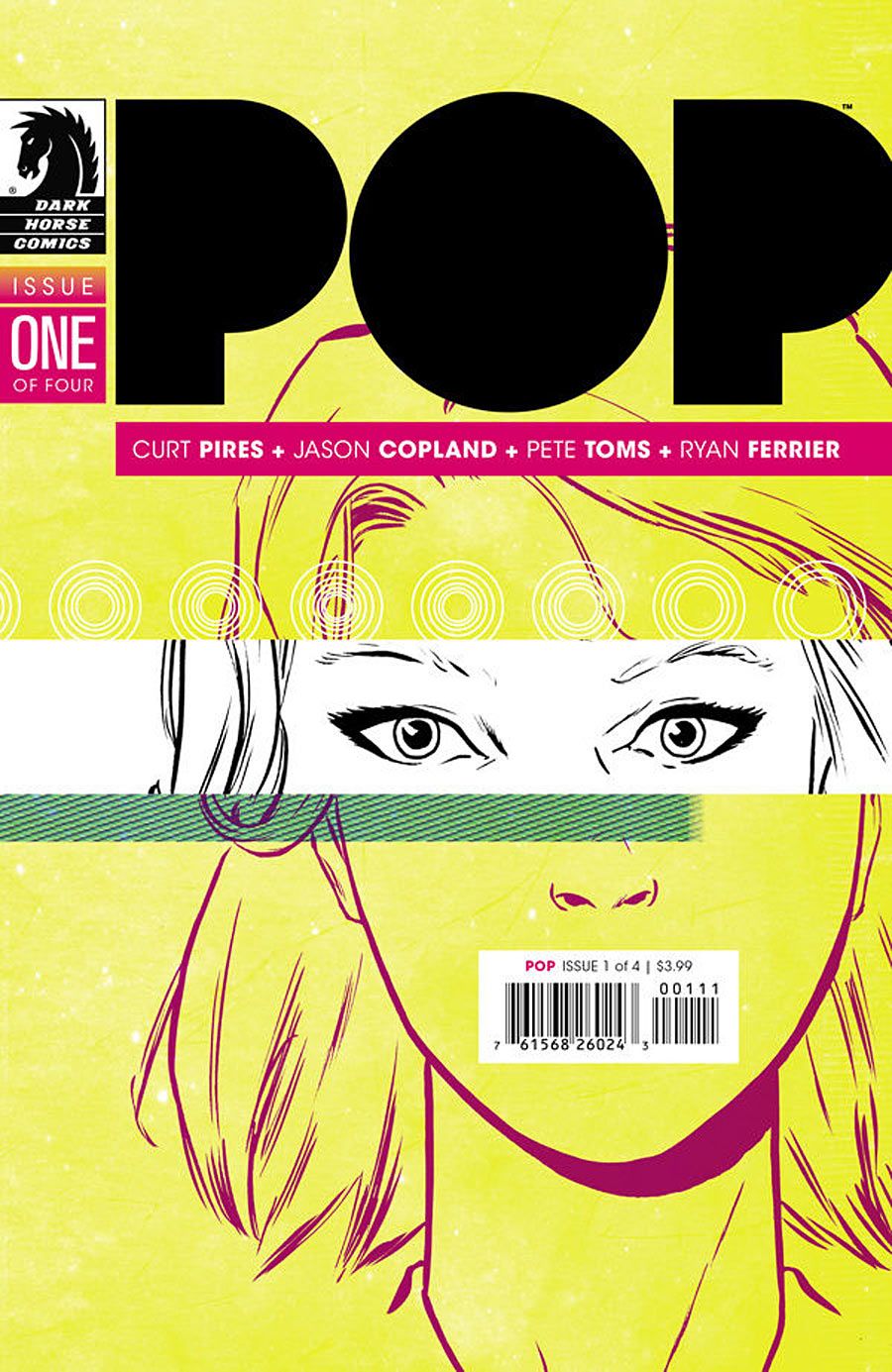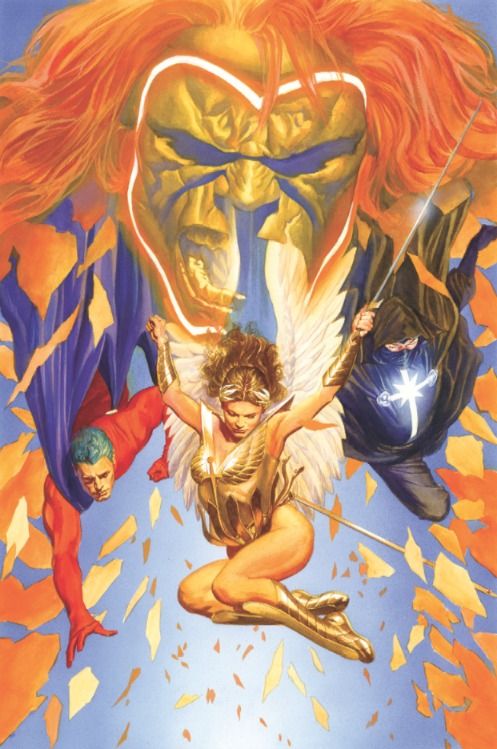As ROBOT 6’s sixth-anniversary celebration winds down, our contributors look back at some of their favorite comics of 2014, from Ms. Marvel and The Multiversity to Sex Criminals and How to Be Happy.
Let us know what some of your favorites of 2014 were in the comments section.
Brigid Alverson
Can't We Talk About Something More Pleasant?, by Roz Chast
Roz Chast's unsparing memoir of her parents' final illnesses is a fascinating and surprisingly funny book. Every family has its quirks, and the Chasts are no exception; what makes this book so compelling the way she links those lifelong traits to the experiences her parents have as they spiral into poor health and suddenly have to cope with new circumstances. She's also willing to laugh at the more incongruous moments. It's a great read and a clear-eyed look at something most of us will have to go through at some point in our lives.
Over Easy, by Mimi Pond
This graphic novel captures perfectly the era just after the 1960s, when, as Mimi Pond puts it, "Watergate had turned political ideals into a joke, and everyone was just treading bong water." She uses that transitional era as the setting for her own story of breaking away from life as an art student to take a job as a waitress in a diner filled with crazy, quirky characters--and eventually being accepted as one of their own.
This One Summer, by Mariko Tamaki and Jillian Tamaki
The team that brought us the amazing teen graphic novel Skim is back with a deeper, more layered story told through the eyes of a girl who is standing on the border between childhood and adolescence, set during a summer vacation that is loaded with tradition and memories. Something is not right with her parents, there's some drama going on with the local teens that she finds fascinating but doesn't quite understand, and her younger friend suddenly seems immature and irritating, at least at times.
Hilda and the Black Hound, by Luke Pearson
Luke Pearson's young protagonist, Hilda, is back in a modern take on The Borrowers; in this story, she befriends an outcast nisse, a house-elf, who lives in the unused spaces of a house, somehow putting them together into a parallel world. Pearson's imaginative tale, likeable heroine, and complex yet comprehensible layouts make this a fun read for kids and a satisfying book for adults as well.
The Undertaking of Lily Chen, by Danica Novgorodoff
Deshi's brother is a drunkard and a troublemaker, but when he dies suddenly in an accident, their parents hold Deshi responsible and send him off to get the corpse of a woman to be buried with his brother so he won't spend eternity alone. It turns out that finding a fresh corpse isn't so easy, even if you are willing to enlist some unsavory help, and Deshi ends up with a live woman, Lily, who has a sharp mind and a determination to escape her rural home. Thrown together by circumstances, they travel together through the mountains, encountering various odd characters along the way, with Lily very much taking the lead--which makes it more and more difficult for Deshi to kill her. Novgorodoff has a beautiful watercolor style which is particularly effective when she shows the ghosts that are lurking in the background.
Helter Skelter, by Kyoko Okazaki
Kyoko Okazaki's nervous line adds a jittery edge to this story of a fashion model who is willing to go to appalling lengths to keep her looks and her status. Under the direction of her "mother" (actually her agent), Ririko undergoes numerous plastic surgeries and attempts to sleep her way to security, but it all comes unraveled as her body begins to break down and her mind starts to go with it. There's a mystery story buried here as well, but the real strength of this book is its indictment of the media's fashion and beauty machine.
The Late Child and Other Animals, by Marguerite Van Cook and James Romberger
This is a memoir of an English childhood but a peculiar one; it starts with Van Cook's mother watching the bombing of Portsmouth during the war and is told in a series of vignettes of her mother's life and her own girlhood. Each of these centers on an epiphany, a moment of realization or transformation, and there are common motifs that wind through the stories, both specific images -- crows, water, even the profile of Marguerite's mother--and more general themes, such as the desire to embrace the world and the realization that it is a dangerous place.
In Clothes Called Fat, by Moyoco Anno
Noko has the co-worker from hell, the beautiful Mayumi, who not only bullies her but steals her boyfriend and gets her in trouble at work as well. Noko thinks that if she loses weight, all her problems will go away, but it doesn't work out that way. Moyoco Anno's story is a harsh critique of the pseudo-morality of body image and the excessive importance placed on it, but it's also a page-turner with some great twists.
Beauty, by Kerascoet and Hubert
Ironically, this twisted fairy tale about a girl who becomes the most beautiful woman in the world, with catastrophic consequences, is itself a thing of great beauty. The story turns the tropes of fairy tales--the handsome prince, the princess in the castle--inside out, but the key here is that it's the men who cause the trouble, although Beauty often gets the blame. The art is gorgeous, done in rich colors in a style reminiscent of art nouveau and the Japanese prints that inspired it.
Nijigahara Holograph, by Inio Asano
This beautifully drawn but elliptically told story is almost relentless in its depiction of the evil that lurks behind everyday life, but it's impossible to put down. Fable and film-noir crime mix in a small town where the children believe a beast living in a tunnel is a sign of the end of the world, and adults cope with the aftereffects of a hideous crime. This is a book that rewards repeated readings, as the story takes place in two different timelines, and some elements don't become clear until later in the book. So it's a challenging read, but a worthwhile one.
Tom Bondurant
Afterlife With Archie (written by Roberto Aguirre-Sacasa and drawn by Franco Francavilla; from Archie Comics)
Sure, at first you look at something which asks “what if the Riverdale gang had to flee a zombie apocalypse?” with a kind of morbid bemusement. Depending on how you feel about Archie and pals’ eternal optimism, you might even root for the zombies. However, Aguirre-Sacasa and Francavilla have grounded their story so firmly in these characters that it’s impossible not to share in their terrors and triumphs.
Aquaman (written by Jeff Parker and penciled by Paul Pelletier and others; from DC Comics)
For years, if not decades, Aquaman has been treated very self-consciously, as creative teams try to insulate the character from mockery. That’s nowhere to be found in Parker and Pelletier’s work. Instead, they’re just telling solid undersea-superhero stories which mix high adventure and monarchical politics. That makes Aquaman one of DC’s most reliably entertaining series.
Astro City (written by Kurt Busiek and pencilled by Brent Anderson and Graham Nolan; from DC Comics/Vertigo)
From the Winged Victory arc to the elderly robot-repairer and the standalone Starbright story, Astro City continues to be one of the best superhero books on the stands. It doesn’t rely upon readers’ affection for its inspirations, whether they be Wonder Woman or Lex Luthor, but instead uses those as springboards for genuinely affecting narratives. Here’s hoping for many more visits.
Batman (written by Scott Snyder and others; penciled by Greg Capullo and others; from DC Comics)
Most of 2014 was taken up by “Zero Year,” an expansive, thrilling epic. Its format gave Snyder and Capullo room to stretch themselves into very productive directions, using each issue to good effect while weaving in themes and references throughout. That would have been enough, but they followed it with the first half of “Endgame,” a suspenseful (and often terrifying) Joker story which may well be the last word on the character for a while. I can’t think of a better combination of character and creative team in the DC superhero stable.
Ms. Marvel (written by G. Willow Wilson and drawn by Adrian Alphonsa; from Marvel)
Hands down my favorite new superhero book and favorite new character. Kamala Khan is everything a reader could want out of a protagonist -- eager, endearing, and filled with fangirl energy. The series’ success is further proof that superhero comics can, and should try to, reach a more diverse audience.
The Multiversity (written by Grant Morrison, penciled by Ivan Reis, Ben Oliver, Chris Sprouse, Frank Quitely and Cameron Stewart; from DC Comics)
Morrison’s travelogue was years in coming but worth the wait. While its themes are nothing new for this writer, its execution has been stunning, especially with the most recent installments, Pax Americana and Thunderworld.
Sex Criminals (written by Matt Fraction and drawn by Chip Zdarksy; from Image Comics)
I could say this series’ simple concept has spun out into an erotically-charged sci-fi rom-com (with a healthy dose of paranoia on top), but that doesn’t seem to capture fully its appeal. Not only have Fraction and Zdarsky created two broken people who have to learn a whole new level of trust, they’ve clearly poured a whole lot of themselves into bringing those characters to life.
Superior Spider-Man and Amazing Spider-Man (written by Dan Slott and others, penciled by Ryan Stegman, Humberto Ramos, and others; from Marvel Comics)
The transition from Otto Octavius back to Peter Parker might have been handled a little more smoothly, and “Spider-Verse” threatens to lose direction, but otherwise writer Dan Slott and his collaborators guided the main Spider-title skillfully from one protagonist to another. It remains an eminently satisfying superhero serial.
Teen Titans: Earth One Vol. 1 (written by Jeff Lemire and drawn by Terry Dodson and Rachel Dodson; from DC Comics)
The best Earth One book to date is also the one that deviates the most from its source material. Only the barest bones of the New Teen Titans’ origin -- a captive Starfire and a questing Raven -- remain in this tale of coming-of-age alienation. Regardless, Lemire and the Dodsons infuse their Titans with enough personality to make the reader anxious for Vol. 2. (A generous helping of Easter eggs don’t hurt either.)
Transformers vs. GI Joe (written by Tom Scioli and Jon Barber and drawn by Scioli; from IDW Publishing)
This literally does for a toy-line crossover what Jack Kirby did for Jimmy Olsen. Before this I hadn’t read a page of a Transformers or G.I. Joe comic, seen more than a few minutes of either cartoon, or played with any of the toys (not counting a random little Autobot from 1986 or so), and I still love this miniseries.
Carla Hoffman
Ms. Marvel
This is the most important comic that came out this year. I want this to be the most important comic for the next year, too. I want people to covet their copies of Ms. Marvel #1 and to talk about the origin of the character the same way they talk about Ultimate Spider-Man. I hope Ms. Marvel is the most important book for years to come.
X-Men Legacy
Every day, I take a couple minutes and remind myself of how much I love this book and its beautiful story. Taking me back to the days when I was a kid reading the X-Men books and applying their outsider status to my own teen years, X-Men Legacy was smart and classic. We never want books like this to end but I think Spurrier gave us about the best ending one could hope for.
Thunderbolts (Soule, Acker/Blacker)
Daniel Way wasn't bad, but Soule and then Acker and Blacker made this book lively and fun in a way I haven't seen since Ellis took his take on the rogue team. Sure, these characters would never work together like the Avengers or X-Men and that's their unique charm.
Black Widow
The comic for people who don't like "comics." Edmondson and Noto are giving you the Black Widow movie people are clamoring for every month in each issue.
Moon Knight (Ellis, Shalvey)
Brilliant done-in-one tales that brought a classy mystery to the character.
She-Hulk (Soule, Pulido)
Leaving us too soon were some fun and fascinating tales of law and order, She-Hulk style. There were two issues right in the middle of their run where the art style changed (and not for the better), but I still love the character and the way she works within the wide world of the Marvel universe. She's a different kind of lawyer than Daredevil, tells a different kind of story than Captain Marvel and has a level of clout within her contemporaries that makes for great stories. Soule was the man to write these issues and I hope he gets a chance in the future to do so again.
Superior Foes of Spider-Man
Spencer and Lieber have comic timing in spades, giving each of Spidey's rogues their own distinct character on their criminal double crossing. I'm sad that the book didn't last too long, but I still think it wrapped up nicely (if a little rushed) and should sit on comics fans' shelves right next to Hawkeye.
New Avengers #21-23
The fireworks factory. These issues bring home to the Hickman's long-running "worlds are colliding" plot to some drastic consequences that are entirely character driven, making things personal and more real than any of the high science he's used so far.
Cyclops
Purely for my husband, who didn't think he was going to care about the generational gap between a swashbuckling pirate and his mutant time-tossed son until Rucka made it personal.
WWE Superstars
No one else is going to mention these comics, but they are so weird. So very very weird and wonderful. I didn't think I would ever demand all the issues of a comic book based on wrestlers living in a world where they have new motivations and problems that are solved with spontaneous wrestling moves, but here we are.
Tim O'Shea
KINSKI by Gabriel Hardman
A black and white comic that Hardman had long wanted to do.The story of a man and a dog that is not his plus so much more. Hardman avoided captions or inner monologues in this narrative, allowing his art to do much of the talking. As often with Hardman, the tinge of noir mixed with the patented style of grittiness to his work just makes Kinski feel like an indie movie you want to lose yourself in.
How to Be Happy by Eleanor Davis
When reading this collection of Davis stories, I found myself reminded of Stuart Immonen's Centifolia books, where he experimented with a variety of art styles and mediums in various stories. Davis does much the same here, to great success, experimenting with color, or use of white space--any number of ambitious elements in a collection of tales partially inspired in some way by her life. When I spoke to her about the collection earlier in 2014, I was drawn by her comment that many of the stories in the latter part of the book tackle "how hard it is to be fully alive — the pain of it, and the bravery of it". Books in that vein should always be treasured.
Stumptown by Greg Rucka and Justin Greenwood
A few months back I wrote that the return of Stumptown made me miss James Garner a little less. Garner's Rockford Files (a slight influence on Stumptown) always had a central appeal of being about a guy who cared for his friends and family. The core appeal, when I consider it to any serious degree, is (beyond the crime solving element of course) that private investigator Dex Parios complete love and devotion for her special needs brother Ansel.
Doctor Mirage by Jen van Meter and Roberto De La Torre
I initially sought this series out as a longtime fan ofvan Meter (she and writer Kathryn Immonen are two of the most underappreciated creators currently not working in comics enough). But what kept me coming back for each installment of the five-issue miniseries is the intense and captivating art of Robert De La Torre when colored by David Baron. Doctor Mirage has the ability to talk to the dead, except for her dead husband. Through flashbacks, you come to appreciate how strong the bond was with her husband--and increasingly hoping that her quest to find him will bring her what she truly seeks.
POP by Curt Pires and Jason Copland
2014 was often an instance of me reading a story because of my interest in the writer, but being even more hooked because of the artist. Pires is an independent writer who has worked with a variety of artists. But he and Copland have an even better rapport than most collaborators do in general. With each page turn, I found myself asking wondering what ambitious or quirky layout that Copland would attempt thanks to Pires script.
You Might As Well Live (it's not a comic book per se, but I nominate it nonetheless) by Darryl Cunningham
Mental health and the potential that anyone could have suicidal ideation should not have a stigma or be swept under the rug. Cunningham's mulling on such issues, while brief, is potent at the same time.
Superior Foes of Spider-Man by Nick Spencer and Steve Lieber
Kudos to the Marvel editor who put these two talents together. The combination of Spencer's great dialogue paired with Lieber's gift for imbuing his art with subtle (and sometimes not so subtle) comedic moments made this comic a must read every month.
Moon Knight by Warren Ellis, Declan Shalvey and Jordie Bellaire
At least once a year or so, Warren Ellis pairs with an artist and proves yet again to the industry how easy it is for him to execute the perfect comics arc. If I was an industry veteran writer who has never achieved the level of success that Ellis has, I would likely hate him. He makes what he pulls off look so easy. The fact that he, Shalvey and Bellaire relaunched Moon Knight as a guy who barely resembles the former version of the longtime Marvel hero and made it such a must read still amazes me. Seriously, only Ellis would pull off "So he is going to wear a white business suit with a mask." Damn.
Southern Bastards by Jason Aaron and Jason Latour
This twisted love letter to the South by Aaron and Latour is an amazing mix reveling in small town insularity, high school football with a dash of unbridled corruption. You cannot help but love it.
Astro City by Kurt Busiek and Brent Anderson
Every time I enter the Astro City limits for another story, I dread every flip of the page knowing it means I am just a little bit closer to leaving Astro City until next month. The fact that Busiek has kept a monthly schedule on the series since its Vertigo relaunch is a major accomplishment for the health-plagued writer. This is not to minimize his health struggles, in fact as a longtime Busiek fan, it gladdened my heart to see Astro City maintain its quality pace of stories in the same year he launched a great Image series like The Autumnlands: Tooth & Claw.
In the realm of honorable mentions, I have one quirky item, followed by comics that almost made my top 10:
The Comics Are For Everybody movement (particularly the t-shirt element) mixed with the We Are Comics Tumblr gave physical proof to the increasing diversity of readership and creators, as well as the need to not let our metaphorical collective foot off of the pedal in terms of aggressively pursuing diversity in comics.
Operation Margarine by Katie Skelly. If my list had been top 11, it would have made the cut, sadly I could not figure out which of my 10 to drop, sorry Skelly.
She-Hulk by Charles Soule & Javier Pulido. Hard to include a series that is cancelled, but the strong storytelling and fun supporting cast makes it one that must be critically respected, despite faltering sales.
Rumble by John Arcudi, James Harren and Dave Stewart. You cannot include a series in a best of 10 with only one issue out, no matter how much I love Arcudi's witty script.
Bitch Planet by Kelly Sue DeConnick and Valentine De Landro. Again, needs more of a track record than one issue.
Spider-Gwen by Jason Latour, Robbi Rodriguez and Rico Renzi. Great costume design, strong alternate universe trappings, solid creative team. But alas, one issue alone is not enough. I expect Spider-Gwen will be in my top 10 for 2015, but no guarantees.
My hero of 2014: Creator Seth Kushner who literally found himself in the fight of his life, faced seemingly insurmountable odds and as of last report is cancer free. Did I mention despite months of hospitalization, he still wrote comic books? Next time you are struggling with a deadline and feel like you have too much on your plate, consider what Kushner tackled in 2014. So glad to have more stories to look forward to from him in 2015.
JK Parkin
1. The Wrenchies by Farel Darymple (First Second)
2. Moon Knight by Warren Ellis and Declan Shalvey (Marvel)
3. Rocket Raccoon by Skottie Young/Jake Parker and friends (Marvel)
4. Manifest Destiny by Chris Dingess and Matthew Roberts (Image/Skybound)
5. The Love Bunglers by Jaime Hernandez (Fantagraphics)
6. Ms. Marvel by G. Willow Wilson and Adrian Alphona (Marvel)
7. The Multiversity by Grant Morrison and friends (DC)
8. Ant Colony by Michael Deforge (Drawn and Quarterly)
9. Shutter by Joe Keatinge and Leila Del Duca (Image)
10. Andre the Giant: Life and Legend by Box Brown (First Second)
11. Head Lopper 2 by Andrew MacLean
12. Daredevil by Mark Waid, Chris Samnee and friends (Marvel)
13. Operation Margarine by Katie Skelly (AdHouse)
14. Copra by Michel Fiffe (Bergen Street Press)
15. The Private Eye by Brian K. Vaughn and Marcos Martin (Panel Syndicate)
16. The Sixth Gun by Cullen Bunn and Brian Hurtt (Oni Press)
17. Copperhead by Jay Faerber and Scott Godlewski (Image)
18. D4VE by Ryan Ferrier and Valentin Ramon (Monkeybrain)
19. The Walking Dead by Robert Kirkman and Charlie Aldard (Image/Skybound)
20. Iron Fist by Kaare Andrews (Marvel)
21. Buffy the Vampire Slayer by Christos Gage and Rebekah Isaacs (Dark Horse)
22. Chew by John Layman and Rob Guillory (Image Comics)
23. Seconds by Bryan Lee O'Malley (Ballantine)
24. Aquaman by Jeff Parker, Paul Pelletier and friends (DC)
25. Ragnarok by Walt Simonson (IDW)
If making comics is really like killing dark elves, all Drow should fear The Wrenchies. Farel Dalrymple offers a multi-layered, beautifully detailed story in his latest graphic novel, combining all the elements you need for a great comic about comics. I also greatly enjoyed his It Will All Hurt comics this year, if you're looking for something less structured. One thing I really enjoyed at Marvel this year was how they were able to match the perfect creators with the perfect characters, and just sort of let them go at it without getting bogged down in continuity, events or what have you. In addition to the titles listed about, books like All-New Ghost Rider, She-Hulk and Elektra are just a lot of fun to read. I also didn't feel like I actually read that many graphic novels this year (several notable ones are still on my "to read pile) so I was surprised they represent as much as my list as they do.
Also I could have kept going past 25; I had about 40-50 titles on my list when I started putting together my 10 choices for the Comic Book Resources top 100 list. I'm sure after I post this I'll think, "Crap, how could I overlook XXX?" Trying to narrow down the long list of stuff I enjoy each year is always both a treat and trial for me; I'm just glad I have so much great stuff to choose from. And I'm thankful for my fellow Robot 6 colleagues and their lists, as it gives me even more stuff to check out!

